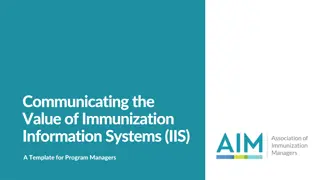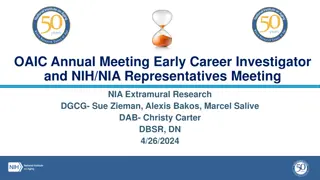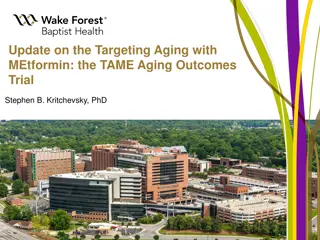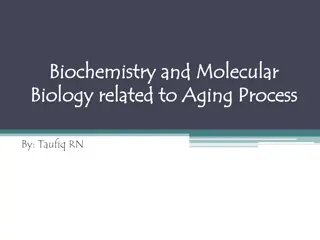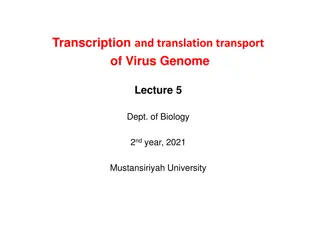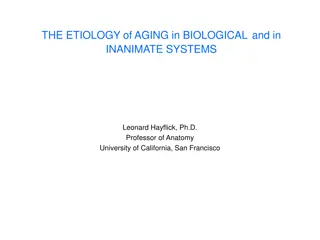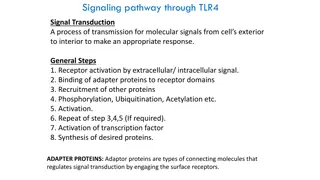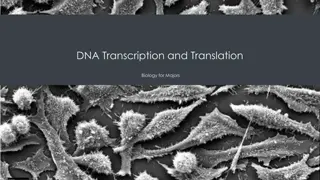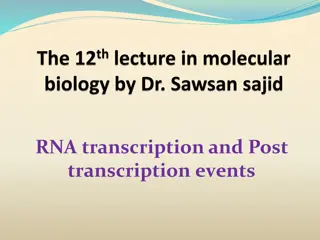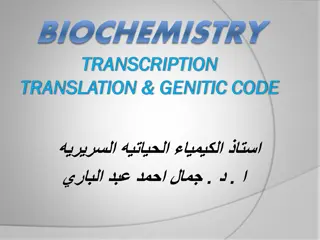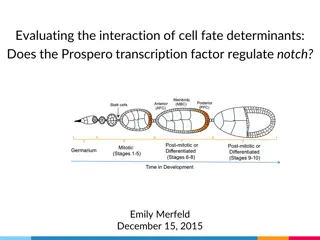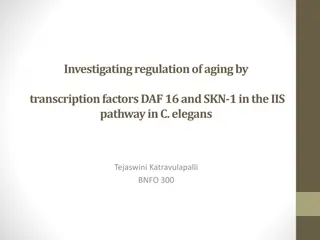Regulation of Aging by Transcription Factors DAF-16 and SKN-1 in the IIS Pathway
Investigating how transcription factors DAF-16 and SKN-1 regulate aging in the IIS pathway of C. elegans can provide valuable insights into longevity and stress resistance. This study explores the molecular mechanisms involved in promoting longevity and controlling gene expression during the down-regulation of the IIS pathway.
Download Presentation

Please find below an Image/Link to download the presentation.
The content on the website is provided AS IS for your information and personal use only. It may not be sold, licensed, or shared on other websites without obtaining consent from the author.If you encounter any issues during the download, it is possible that the publisher has removed the file from their server.
You are allowed to download the files provided on this website for personal or commercial use, subject to the condition that they are used lawfully. All files are the property of their respective owners.
The content on the website is provided AS IS for your information and personal use only. It may not be sold, licensed, or shared on other websites without obtaining consent from the author.
E N D
Presentation Transcript
Investigating regulation of aging by transcription factors DAF 16 and SKN-1 in the IIS pathway in C. elegans Tejaswini Katravulapalli BNFO 300
Introduction Aging in eukaryotic organisms is a deleterious process that can result in changes in metabolism, reproduction and physiology Understanding molecular pathways of aging and regulation can lead to developing methods to decrease effects of age- linked diseases, therefore improving human health and lifespan There have been many studies conducted on model invertebrate organisms such as Caenorhabditis elegans (C. elegans) that have found genes that have a significant effect on longevity.
Background Information The Insulin/insulin like growth factor (IGF)-1 signaling (IIS) pathway has been shown to regulate aging in many organisms The role of the IIS pathway encompasses connecting functions like reproduction and aging to nutrition sensing is highly conserved, which gives it increasing importance to study. Caenorhabditis Elegans, also known as the roundworm is an ideal invertebrate model to study aging as it has a short lifespan, along with a low cost
Insulin/Insulin like growth factor signaling (IIS) pathway Peptides secreted in response to food bind to DAF-2/IGF-1 This activates AGE-1/PI3K in turn activating AKT-1, AKT-2 and PDK-1 DAF-16 is phosphorylated, which is a homolog of the FoxO transcription factors in humans Phosphorylation translocates it from the nucleus to the cytoplasm When IIS is down regulated, DAF-16 is able to promote expression of longevity and stress resistance related genes in the nucleus It acts with along with HSF-1 and SKN-1
Research Question and Hypothesis SKN-1 is also isolated to the cytoplasm through phosphorylation by AKT-1/-2 and other protein kinases Longevity phenotypes produced by DAF-16 and SKN-1 mutants are similar, which suggests that they might function together to increase the lifespan of C. elegans They are also both inhibited by IIS in a similar way Do DAF-16 and SKN-1 regulate each other to control the promotion of longevity related gene expression during the down regulation of the IIS pathway in C. elegans?
Experimental Objective The objective of this experiment is to determine if SKN-1 and DAF-16 act together to promote longevity in C. elegans, through a reduction in the IIS pathway Testing a DAF-2 mutant for longevity without altering expression of any other factors will serve as the control. Then DAF-2/SKN-1 double mutants will be used to determine what phenotypes are expressed and if the lifespan can be altered by DAF-16 without SKN-1. The same will be done using a DAF-2/DAF-16 double mutant
Methods The target genes will be cloned and amplified by PCR from the genomic DNA of the desired strains of C. elegans RNA interface: RNA interface also known as Post- Transcriptional gene silencing is a process that can regulate the expression of protein coding genes. C. elegans will be fed worms of E. coli, which are genetically modified to induce transcription of dsRNA that is homologous to a target gene Oxidative stress response: Stage 4 larvae will be exposed to varying concentrations of 5-hydroxy-p-napthoquinone (juglone). This exposure will mimic oxidative stress and is able to form damaging proteins that the C. elegans need to recover from
Methods GFP Fusion protein scoring system: GFP, also known as green fluorescent protein can be visualized by fluorescent microscopy. It will be used in this experiment to tag the sequences of the transcription factors to see how efficiently they travel to the nucleus to promote their target genes Lifespan and Healthspan analysis: The lifespan of C. elegans must be monitored periodically from hatching to study the adaptive reactions to oxidative stress. To measure the mutants health, movement assays will be performed
Conclusion If the DAF-2/DAF-16 mutant shows decreased signs of longevity, then this will indicate that SKN-1 is related to DAF-16 in some way that affects its ability to increase lifespan Results that show that the two transcription factors are related will provide insight into how similar homologs in humans and other mammals also act together to further the lifespan and healthspan In the case that the two transcription factors are not related to each other, experiments with different methods could be used to confirm these results DAF-16 could be tested with other transcription factors, to see which ones play a role in its regulation
References Altintas, O., Park, S., & Lee, S.-J. V. (2016). The role of insulin/IGF-1 signaling in the longevity of model invertebrates,C. elegans and D. melanogaster.BMB Reports,49(2), 81 92. http://doi.org/10.5483/BMBRep.2016.49.2.261 Eleftherianos, I., & Castillo, J. C. (2012). Molecular Mechanisms of Aging and Immune System Regulation in Drosophila.International Journal of Molecular Sciences, 13(8), 9826 9844. http://doi.org/10.3390/ijms13089826 Hsu, A., Murphy, C. T., & Kenyon, C. (2003). Regulation of Aging and Age-Related Disease by DAF-16 and Heat-Shock Factor.Science,300(5622), 1142-1145. doi:10.1126/science.1083701 Murphy, C. T. (2013). Insulin/insulin-like growth factor signaling in C. elegans. WormBook,1-43. doi:10.1895/wormbook.1.164.1 Przybysz, A. J., Choe, K. P., Roberts, L. J., & Strange, K. (2009). Increased age reduces DAF-16 and SKN-1 signaling and the hormeticresponse of Caenorhabditis elegans to the xenobiotic juglone. Mechanisms of Ageing and Development,130(6), 357-369. doi:10.1016/j.mad.2009.02.004 Snapp, E. (2005). Design and Use of Fluorescent Fusion Proteins in Cell Biology. Current Protocols in Cell Biology / Editorial Board, Juan S. Bonifacino ... [et Al.], CHAPTER, Unit 21.4. http://doi.org/10.1002/0471143030.cb2104s27 Tullet, J. M. A., Hertweck, M., Hyung An, J., Baker, J., Hwang, J. Y., Liu, S., Blackwell, T. K. (2008). Direct inhibition of the longevity promoting factor SKN-1 by Insulin-like signaling in C. elegans. Cell, 132(6), 1025 1038. http://doi.org/10.1016/j.cell.2008.01.030 Uno, M., & Nishida, E. (2016). Lifespan-regulating genes in C. elegans. Npj Aging and Mechanisms of Disease,2(1). doi:10.1038/npjamd.2016.10 Van Heemst, D. (2010). Insulin, IGF-1 and longevity.Aging and Disease,1(2), 147 157.



